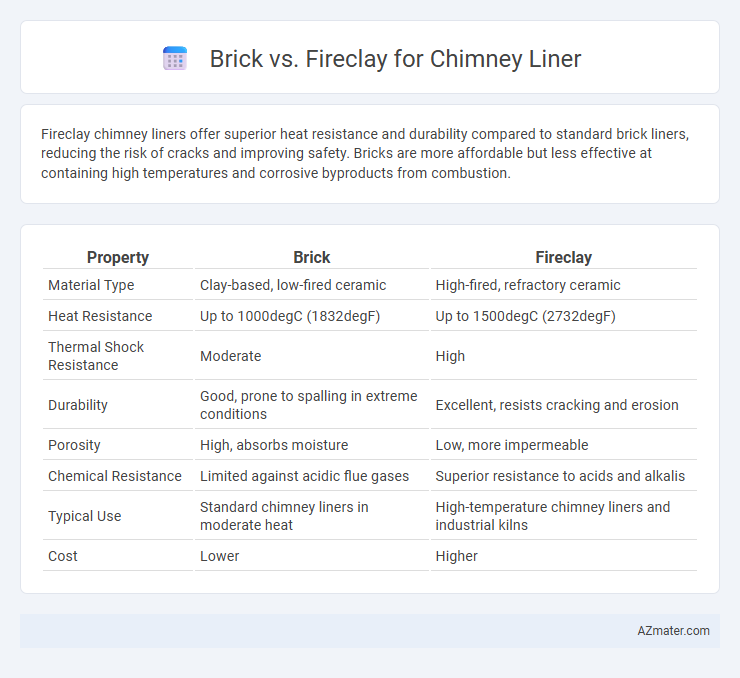Fireclay chimney liners offer superior heat resistance and durability compared to standard brick liners, reducing the risk of cracks and improving safety. Bricks are more affordable but less effective at containing high temperatures and corrosive byproducts from combustion.
Table of Comparison
| Property | Brick | Fireclay |
|---|---|---|
| Material Type | Clay-based, low-fired ceramic | High-fired, refractory ceramic |
| Heat Resistance | Up to 1000degC (1832degF) | Up to 1500degC (2732degF) |
| Thermal Shock Resistance | Moderate | High |
| Durability | Good, prone to spalling in extreme conditions | Excellent, resists cracking and erosion |
| Porosity | High, absorbs moisture | Low, more impermeable |
| Chemical Resistance | Limited against acidic flue gases | Superior resistance to acids and alkalis |
| Typical Use | Standard chimney liners in moderate heat | High-temperature chimney liners and industrial kilns |
| Cost | Lower | Higher |
Introduction to Chimney Liner Materials
Brick and fireclay are two common materials used in chimney liners, each offering distinct benefits in durability and heat resistance. Brick liners provide excellent thermal mass, which helps in retaining heat and protecting the chimney structure, while fireclay liners excel in withstanding high temperatures and chemical corrosion from flue gases. Selecting the appropriate chimney liner material depends on the specific requirements of the chimney system, such as fuel type, temperature range, and maintenance considerations.
What Is Fireclay?
Fireclay is a dense, refractory ceramic material composed mainly of kaolin clay, silica, and alumina, specifically formulated to withstand high temperatures in chimney liners. Its high heat resistance and low porosity make fireclay an ideal choice for protecting chimney structures from thermal stress and corrosive byproducts of combustion. Fireclay liners offer enhanced durability and a smoother internal surface compared to traditional brick, improving draft efficiency and safety in chimney systems.
Understanding Brick Chimney Liners
Brick chimney liners are constructed from clay bricks that offer strong durability and heat resistance, making them an effective barrier against combustion gases. Their porous nature provides excellent insulation, reducing the risk of heat transfer to surrounding structures and enhancing fire safety. Regular maintenance is essential to check for cracks or deterioration that can compromise the liner's effectiveness over time.
Durability Comparison: Brick vs Fireclay
Fireclay chimney liners exhibit superior durability compared to traditional brick liners due to their high resistance to thermal shock and chemical corrosion from acidic flue gases. Bricks, while robust, are more prone to cracking and spalling over time under extreme temperature fluctuations and continuous exposure to moisture. Fireclay's dense, vitrified composition ensures a longer lifespan and fewer maintenance requirements, making it the preferred choice for long-term chimney protection.
Heat Resistance and Thermal Performance
Fireclay chimney liners offer superior heat resistance compared to traditional brick, withstanding temperatures up to 2300degF (1260degC) without cracking. Their dense, vitrified composition enhances thermal performance by minimizing heat transfer and preventing chimney damage. In contrast, brick liners absorb more heat and may degrade faster under prolonged high-temperature exposure, reducing overall chimney efficiency and safety.
Maintenance Requirements and Longevity
Fireclay chimney liners exhibit superior resistance to heat and corrosion, resulting in lower maintenance requirements compared to traditional brick liners. Brick chimney liners are more porous, which may lead to faster deterioration and frequent repairs, especially under exposure to creosote and moisture. Choosing fireclay liners can extend chimney lifespan by reducing the risk of cracks and structural damage over time, ensuring enhanced durability and performance.
Installation Process: Fireclay vs Brick
Fireclay chimney liners are typically installed as pre-formed, smooth tubes that fit directly into the chimney, providing a straightforward, uniform lining with less customization needed during installation. In contrast, brick chimney liners require skilled masons to build a custom brick lining within the flue, which can be labor-intensive and time-consuming but offers greater flexibility in shape and thickness. Fireclay installation tends to be quicker and less prone to sealing issues, whereas brick liners demand precise mortar application and joint alignment to ensure durability and prevent leaks.
Cost Analysis: Brick vs Fireclay Liners
Brick chimney liners typically cost between $10 to $20 per linear foot, making them a more budget-friendly option compared to fireclay liners, which range from $15 to $25 per linear foot due to their specialized manufacturing process and higher heat resistance. Installation costs for brick liners may be higher because of the labor-intensive masonry work, whereas fireclay liners often allow for quicker installation, potentially offsetting some material expenses. Long-term maintenance and durability factors also influence cost-effectiveness, with fireclay liners generally requiring less frequent repairs, resulting in lower lifetime expenses despite the initial higher investment.
Safety Considerations and Code Compliance
Fireclay chimney liners offer superior resistance to high temperatures and chemical corrosion compared to traditional brick, enhancing overall chimney safety by reducing the risk of cracks and leaks that can lead to hazardous gas escapes. Building codes often mandate the use of fire-resistant materials like fireclay or stainless steel liners to ensure proper containment of combustion byproducts, making brick liners less favorable due to their porous nature and potential for deterioration over time. Compliance with local fire and building regulations requires choosing chimney liners that meet specific heat tolerance and durability standards, with fireclay frequently specified for its established safety record and long-term reliability.
Choosing the Best Chimney Liner for Your Home
Fireclay chimney liners offer superior heat resistance and durability compared to traditional brick liners, making them ideal for high-temperature fire applications and long-term use. Brick liners, while cost-effective and widely available, typically lack the thermal efficiency and sealing properties of fireclay, potentially leading to increased creosote buildup and chimney degradation. Selecting a fireclay liner ensures safer chimney operation and enhanced structural protection, particularly in homes with frequent or intense fireplace use.

Infographic: Brick vs Fireclay for Chimney Liner
 azmater.com
azmater.com